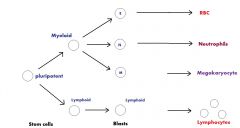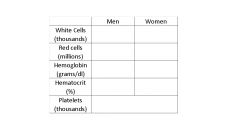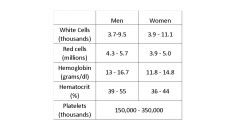![]()
![]()
![]()
Use LEFT and RIGHT arrow keys to navigate between flashcards;
Use UP and DOWN arrow keys to flip the card;
H to show hint;
A reads text to speech;
53 Cards in this Set
- Front
- Back
|
where is plasma synthesized?
|
mainly in the liver
|
|
|
where are RBC's synthesized?
|
bone marrow
|
|
|
where are neutrophils synthesized?
|
bone marrow
|
|
|
where are platelets synthesized?
|
bone marrow
|
|
|
where are lymphocytes made?
|
bone marrow, lymph nodes, and spleen
|
|
|
Describe the cell sythesis process that occurs in bone marrow
|
1. Myeloid stem cells are the precursors of neutrophils, RBC's and megakaryocytes
2. Myeloid stem cells differentiate into blasts, the precursors for each cell type 3. Growth factors cause blasts to divide and mature. Blasts eventually lose ability to divide 4. Mature neutrophils and RBC's enter blood 5. Megakaryocytes break into small fragments (platelets) and enter blood |
|
|
What is a stem cell?
|
a cell that can reproduce itself indefinitely and that can differentiate into one or more types of mature cells
|
|
|
What are the three types of stem cells and what blast do they produce?
|

|
|
|
erythropoietin
|
growth factor that stimulates red cell production
|
|
|
thrombopoietin
|
growth factor that stimulates platelet production
|
|
|
G-CSF
|
growth factor that stimulates neutrophil production and activates neutrophil function
|
|
|
granulocyte
|
neutrophil
|
|

|

|
|
|
polythermia
|
too many RBC's
|
|
|
What are the three primary functions of blood?
|
1. transport oxygen, nutrients, and waste products
2. fight infection 3. prevent bleeding |
|
|
hematocrit
|
proportion of blood volume occupied by red cells
|
|
|
Function of neutrophils
|
- eat bacteria
- produce inflammatory molecules |
|
|
Function of Lymphocytes
|
- make antibodies
- kill foreign or infected cells - regulate immune system |
|
|
Function of Monocytes
|
- eat bacteria and other unwanted things
- regulate immune system |
|
|
platelets are fragments of large cells called _______________ and their primary functions are_________ and _____________
|
megakaryocytes
help blood clot and prevent bleeding |
|
|
What are the two mechanisms by which lymphocytes "go bad" and become lymphomas?
|
1. Sometimes normal DNA rearrangement (necessary for producing a variety of cells that respond to different antigens) is not accomplished properly and the cell gains a growth advantage over it neighbors
2. The normal apoptosis program is faulty and the cell continues to divide indefinitely |
|
|
anemia
3 causes |
reduced total red cell mass
causes: 1. blood loss 2. red cell destruction (hemolysis) 3. decreased red cell production |
|
|
macrocytic
normocytic microcytic |
macrocytic - big red cells
normocytic - normal size red celld microcytic - small red cells |
|
|
reticulocytes
|
newly made red cells
- number in blood proportional to rate of red cell production |
|
|
What disease state would cause a low reticulocyte?
What disease state would cause a high reticulocyte? |
bone marrow not working --> low reticulocyte
anemia --> high reticulocyte |
|
|
What are the causes of anemia
(3 main, 2 mains have 2 subsets) |
1. Decreased red cell production
a. stem cell damage (usually low neutrophils & platelets, too) b. defective red cell maturation 2. Increased red cell destruction a. Intrinsic defect in rbc leading to shortened lifespan b. External factors in blood or vessels destroy rbc's 3. Blood loss |
|
|
pancytopenia
|
low numbers of rbc, neutrophils, & platelets in blood due to meloid cell damage and shut down of marrow
|
|
|
Aplastic Anemia
- Causes (4) - Treatments (3) |
a stem cell disorder of decreased numbers of hematopoietic stem cells
Causes: 1. cytotoxic chemicals 2. ionizing radiation (atomic bomb) 3. viral infection 4. idiopathic (prob. autoimmune) Treatments: 1. supportive (transfusions, antibiotics) 2. immune suppression 3. bone marrow/stem cell transplantation |
|
|
What is the most common type of anemia?
|
amenia secondary to other diseases which cause decrease in rbc production
(e.g. infection, arthritis, kidney failure, cancer, malnutrition) - resolves when causitive disorder treated or may be treatable with synthetic erythropoietin - |
|
|
What is the most common cause of anemia?
|
iron deficiency anemia
- microcytic - small, pale cells due to decreased hemoglobin production Causes: chronic blood loss, pregnancy, poor diet, inability to absorb iron Treatment: replace iron, rule out/treat bleeding |
|
|
What is the pathophysiology of anemia due to Vitamin B-12 deficiency?
Cause? Treatment? |
Macrocytic - B-12 needed for DNA synthesis, so cells grow but can't divide
- usually due to poor absorption, not diet Cause: Pernicious Anemia - stomach disorder causing lack of factor which aids B-12 absorption Treatment: B-12 injections |
|
|
What is the pathophysiology of anemia due to folic acid deficiency?
Causes? Treatment? |
Macrocytic - folic acid needed for DNA sythesis, so cells don't divide
Causes: poor diet, alcohol abuse, certain meds Treatment: oral supplements |
|
|
Thalassemia
Compare t-minor to t-major |
An inherited disorder in which rbc's can't make the protein part of hemoglobin
T-minor is mild or moderate disease and provides some protection from malaria T-major occurs when child inherits bad gene from both parents. Life threatening condition where little to no hemoglobin is made. Survival depends on rbc transfusions. |
|
|
Hemolytic Anemia
|
increased rate of red cell destruction
- causes increased bilirubin production and jaudice - often occurs in spleen and splenectomy may cause improvement |
|
|
Inherited Hemolytic Amenia
|
Sickle Cell Anemia
- hooked, inflexible cells clog up vessels - can treat symptoms, cannot cure |
|
|
Autoimmune Hemolytic Anemia
|
A production of "autoantibodies" against ones own red cells
- antibodies coat cells andlead to destructionin spleen and liver by macrophages - detected by positive "Coombs Test" Treatment: corticosteroids or other immunosuppressive drugs, splenectomy |
|
|
Transfusion reaction
|
occurs when someone is given blood of the wrong type
- may cause shock, kidney failure, bleeding, death |
|
|
Polycythemia
Polycythemia vera: Secondary Polycythemia: |
Increased total red cell volume
- thick blood can cause thrombosis and other circulatory disorders vera: increased, unregulated red cell production, usually due to mutation in marrow which makes rbc precursors more sensitive to erythropoietin secondary: increased erythropoietin production due to decreased oxygen delivery to kidney (and in blood) |
|
|
Neutropenia
- 2 types |
decreased neutrophils
1. decreased production (marrow failure, chemotherapy) 2. increased consumption (infection, enlarged spleen, autoimmune) |
|
|
Leukemia
4 types |
malignant proliferation of white cells and/or their precursors (blasts)
Myelogenous (Neutrophil precursors) - AML: acute myelogenous leukemia - CML: chronic myelogenous leukemia Lyphocytic - ALL: acute lymphocytic leukemia - CLL: chronic lymphocytic leukemia Chronic leukemias - more mature cells, slow growing Acute leukemias - immature cells (blasts), fast-growing |
|
|
Pathophysiology of Leukemia
|
- bone marrow failure due to filling with leukemic cells
- Leukemic cells in marrow get into blood --> - impaired circulation - leukemic cells in organs - toxic substances from leukemic cells |
|
|
purpura in leukemia
|
low platelet count leads to bleeding
|
|
|
Acute myelogenous leukemia (AML)
|
- more adults than children
- fatal if untreated - intensive chemo may get remission, occasional cure - bone marrow transplant sometimes cures |
|
|
Acute lymphocytic leukemia (ALL)
|
- children & adults (most common childhood leukemia)
- fatal if untreated - curable with chemo or bone marrow transplant - curable > 75% of children |
|
|
Chronic myelogenous leukemia (CML)
|
- rare in children
- treatable, but can be fatal sometimes curable with bone marrow transplant |
|
|
Chronic lymphocytic leukemia (CLL)
|
- middle-aged and older
- treatable but incurable - not all patients need treatment |
|
|
Lymphomas
|
cancer of lymphocytes and their precursors
- tumors form in lymph nodes, spleen, marrow, other organs - many different kinds: Hod/non-Hod, B-cell, T-cell... - usually treatable, sometimes curable |
|
|
Non-Hodgkin's Lymphoma
|
Low Grade:
- cells appear mature - slow growing, patients may live years - treatable, but generally incurable - usually older people High Grade: - cells less mature - faster growing, fatal in months - often curable with chemo - sometimes in children |
|
|
What is a rule of thumb regarding maturity of cancer cells and growth rate in Non-Hodgkin's Lymphomas?
|
The less mature the cancer cell, the faster growing the lymphoma, and the more likely the disease is to affect younger people and to be curable
|
|
|
Hodgkin's Disease
|
- almost always begins in lymph nodes
- spreads gradually to other nodes and organs - relatively common in young adults - often curable with radiation or chemo |
|
|
What are the rules of thumb for survival rates of low and high grade non-Hodgkin's lymphoma?
|
Low: good survival for 5-10 yr, then death rate increases
High: if patient makes it 5 yr, good chance of long term survival |
|
|
What are the staging classifications of Hodgkin's Disease?
What are the differences in treatment for stages? |
Stage I: single node or contiguous group of nodes
Stage II: more than one node group, one side of diaphragm Stage III: confined to nodes, present both sides Stage IV: spread outside of nodes A: no symptoms B: symptoms (fever, weight loss, night sweats) Treatment of lower stage - radiotherapy Treatment of higher stage - chemo |
|
|
Multiple Myeloma
|
cancer of plasma cells
- monoclonal immunoglobulin may damage kidneys, other organs - bone destruction, bone marrow failure - treatable, not curable ***a bad one, generally worse than Hod's & lymphoma*** |

